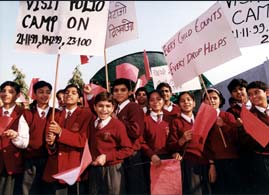| |
| |
 |

© WHO/Marcel
Crozet |
 |

School
children in New Delhi, the capital, rally in support of a nation-wide
polio vaccination campaign in December 1999. That month, India vaccinates
150 million children in just a few days — the largest public
health event ever undertaken. The same year, the World Health Assembly
resolves to intensify the global effort and recommends adding a "door-to-door"
strategy to reach every child under five. New annual cases of polio
paralysis drop to 20,000.
  |
 |
| |
|
|
|
|
|


